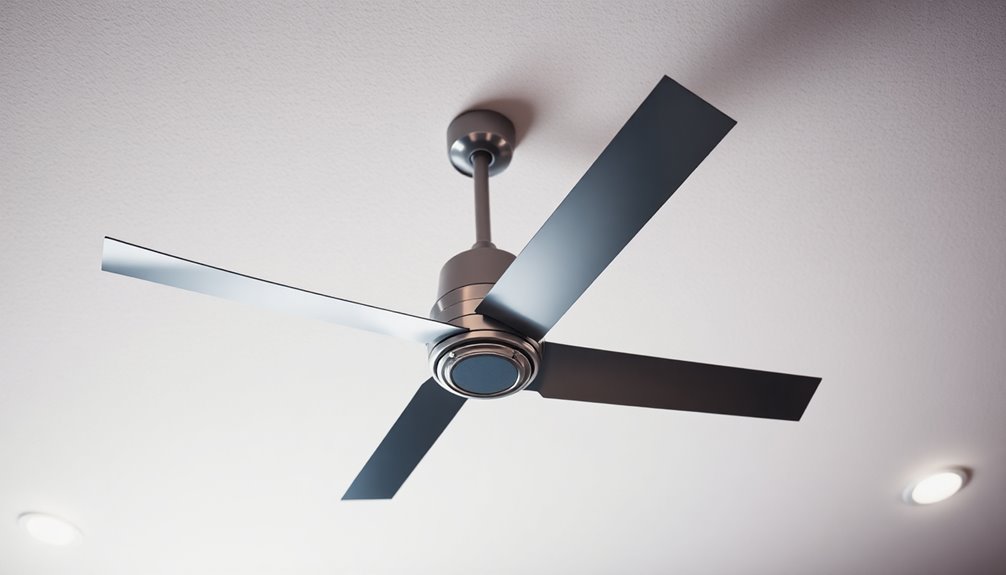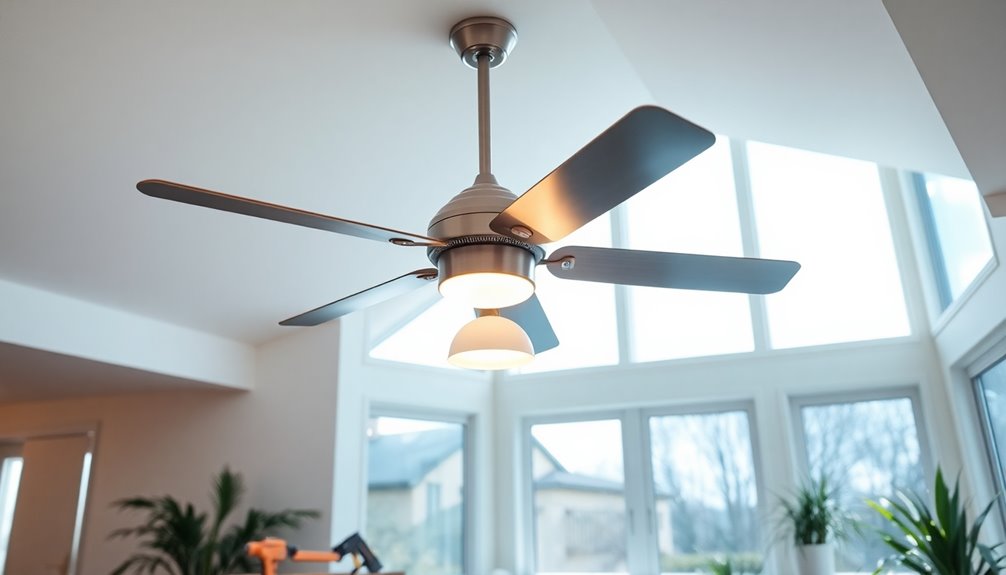For your 12×14 room, it's best to choose a ceiling fan with a diameter between 42 to 54 inches. This size guarantees ideal airflow and comfort throughout the space. Ideally, a blade span of 44 to 48 inches provides the perfect balance of aesthetics and efficiency. Aim for a CFM rating between 1,600 to 4,500 for effective air movement. Remember to take into account your ceiling height and confirm there's at least 18 inches of clearance from the walls. Proper sizing not only enhances comfort but can also save on energy costs. There's more to explore about fan types and installation!
Key Takeaways
- Ideal ceiling fan diameter for a 12×14 room is between 42 to 54 inches for effective airflow and comfort.
- Aim for a blade span of 44 to 48 inches to maximize aesthetics and air circulation in the space.
- Ensure the fan's CFM rating falls between 1,600 to 4,500 for optimal cooling and energy efficiency.
- Maintain 18 inches of clearance from walls and consider furniture layout to enhance airflow performance.
- Choose a flush mount for ceilings under 8 feet and a downrod mount for ceilings over 9 feet for proper installation.
Ceiling Fan Size Recommendations

When choosing a ceiling fan for your 12×14 room, you'll want to look for one with a diameter between 42 to 54 inches to guarantee ideal air circulation. A fan with a blade span of 44 to 48 inches is perfect for balancing both airflow and aesthetics in this space. This size not only enhances comfort but also contributes to energy efficiency.
It's vital to check the fan's CFM (Cubic Feet per Minute) rating as well. For rooms of this dimension, aim for a CFM between 1,600 to 4,500 to guarantee effective cooling or air circulation. This rating indicates how well the fan moves air, which is necessary for maintaining a comfortable environment.
Additionally, consider your room's ceiling height when selecting your fan. If your ceiling is between 8 to 9 feet, a downrod mount might be beneficial. This setup can improve airflow by positioning the fan at the ideal height.
Ultimately, choosing the right ceiling fan size won't only make your room feel better but also help reduce electricity costs associated with heating and cooling.
Measuring Your Room

To find the right ceiling fan for your 12×14 room, start by calculating the square footage, which is 168 square feet.
This measurement will guide you in selecting a fan with a blade span between 42 and 54 inches for ideal airflow.
Don't forget to take into account your ceiling height, as it impacts installation and effective circulation.
Room Dimensions Calculation
Measuring your room accurately is vital for selecting the right ceiling fan size. Start by measuring the dimensions of your room. For a 12×14 room, multiply the length (12 feet) by the width (14 feet) to determine the square footage, which comes out to 168 square feet. This calculation is significant because the size of the room directly impacts the ceiling fan sizes you should consider.
For a space between 144 to 225 square feet, a ceiling fan with a diameter of 44 to 50 inches is ideal. This size guarantees effective airflow and comfort.
Don't forget to check the CFM (Cubic Feet per Minute) rating of the fan. Aim for a range of 1,600 to 4,500 CFM to achieve the best cooling in your medium-sized room.
Additionally, consider your ceiling height. If your room has a standard height of 8-9 feet, you might need a flush mount or downrod mount for proper installation.
Finally, confirm the fan's blade span complements the design and layout of the room to avoid a look that feels out of place.
Fan Size Recommendations
Choosing the right fan size for your 12×14 room involves considering both the room dimensions and airflow needs. For ideal air circulation, you'll want a ceiling fan that's between 42 to 54 inches in diameter. This size will guarantee that you get adequate airflow throughout the space.
Regarding CFM, aim for a fan that offers between 1,600 to 4,500 CFM to effectively cool your room.
First, double-check your room's measurements to confirm the total square footage, which is 168 square feet. This is vital because it directly influences the size of the ceiling fan you need.
If your ceiling height exceeds 9 feet, consider using a standard downrod to maintain proper airflow. A fan with a higher CFM rating can greatly enhance comfort levels and energy efficiency in your medium-sized room.
Ultimately, the right ceiling fan size won't only improve your cooling experience but also help in maintaining a comfortable atmosphere in your home.
Airflow Considerations
Understanding how the layout of your room impacts air circulation is key to maximizing the effectiveness of your ceiling fan. For a 12×14 room, which is 168 square feet, you'll want to choose a ceiling fan with a blade span of 42 to 54 inches. This size ceiling fan will help guarantee ideal airflow throughout the space.
When considering airflow, pay attention to the fan's CFM (Cubic Feet per Minute) rating. Aim for a fan that offers a CFM between 1,600 to 4,500. This range guarantees the fan can adequately cool your room, regardless of how it's arranged.
Additionally, think about your furniture layout. Items like couches or bookcases can obstruct airflow; positioning the fan in a way that allows free movement of air is essential.
Installing the ceiling fan at a height of 7 to 9 feet above the floor will enhance airflow efficiency and comfort too.
Understanding CFM Ratings

CFM, or Cubic Feet per Minute, measures how much air a ceiling fan can move, which directly impacts your comfort level.
For your 12×14 room, you'll want a fan with a CFM rating between 1,600 and 4,500 for ideal airflow.
Understanding this rating helps you choose a fan that cools effectively and keeps your energy bills in check.
CFM Rating Explained
When it comes to selecting a ceiling fan, knowing the CFM rating is vital for making certain your space stays comfortable. CFM, or Cubic Feet per Minute, measures the volume of air a ceiling fan can move in one minute, giving you a clear indication of its airflow capacity.
For a room size of 12×14 feet, look for a ceiling fan with a CFM rating between 1,600 and 4,500. This range typically provides effective cooling and comfort.
Remember, not all fans with the same blade span will have the same efficiency. That's why comparing CFM ratings is significant in your selection process. A higher CFM rating generally means better air circulation, which can be particularly beneficial in medium-sized rooms like yours.
Additionally, consider your room's layout when choosing a fan. Factors like furniture placement and ceiling height can affect airflow patterns, so it's important to think about how these elements will interact with your chosen fan.
Ideal CFM Range
Selecting the right CFM rating for your ceiling fan can greatly enhance your comfort in a 12×14 room. The ideal CFM range for such a space typically falls between 1,600 and 4,500. This guarantees adequate air circulation, preventing the room from feeling stuffy or too warm.
CFM ratings indicate how much air a fan can move; higher ratings are more effective for larger areas, while lower ratings may suffice in smaller spaces.
When choosing a ceiling fan, opt for a size between 42 and 54 inches in diameter to match the dimensions of your 12×14 room. Additionally, consider fans with higher blade pitches, as they often provide better airflow efficiency, helping you achieve the desired CFM ratings.
Understanding the connection between your room size and the fan's CFM rating is essential. Improper sizing can lead to inadequate cooling and increased energy costs.
Impact on Comfort
Understanding how CFM ratings impact comfort in your 12×14 room can greatly enhance your living experience. The CFM, or Cubic Feet per Minute, rating of a ceiling fan indicates its air-moving capacity. For your room size, look for a ceiling fan with a CFM rating between 1,600 and 4,500. This guarantees peak airflow, effectively cooling the space while maintaining a comfortable atmosphere.
Fans with higher CFM ratings circulate air more efficiently, which can considerably improve comfort levels. By choosing a well-sized ceiling fan, you not only achieve better airflow but also promote consistent temperature control. This reduces your reliance on air conditioning, leading to energy savings and a more pleasant environment.
When selecting a ceiling fan, consider both the size and CFM rating to match your specific cooling needs. A fan that suits your room's dimensions and CFM requirements will maximize energy efficiency and enhance your overall comfort.
Blade Span for 12×14 Room

For a 12×14 room, choosing the right blade span is essential for effective air circulation. You'll want a ceiling fan with a blade span between 42 to 54 inches to guarantee adequate airflow throughout the space.
Fans in the 44-inch range are often considered ideal, striking a perfect balance between airflow and aesthetics. This size helps maintain comfort by effectively cooling in the summer and distributing heat in the winter.
When considering the size of your room, proper fan sizing can also enhance energy efficiency. A correctly sized ceiling fan will maximize airflow without wasting energy, helping you save on utility bills.
Types of Ceiling Fan Mounts

Choosing the right ceiling fan mount is essential for achieving ideal airflow in your room. The type of mount you select—flush mount, downrod mount, or angled mount—depends on your ceiling height and slope.
If your ceiling is under 8 feet, a flush mount is your best option. This low-profile design maximizes headroom and minimizes blade obstruction, ensuring you have enough space to move freely.
For higher ceilings, consider a downrod mount. This type uses a long pole to suspend the ceiling fan, allowing for better airflow above furniture and decor.
If your ceiling is sloped, an angled mount is necessary. These mounts keep the fan blades at a favorable angle, ensuring they maintain adequate clearance from the ceiling and walls for efficient operation.
Installing the Ceiling Fan

Installing a ceiling fan can transform your room's comfort and ambiance. To begin, you'll want to measure your ceiling height to guarantee proper installation. Ideally, the fan should be 7 to 9 feet above the floor for ideal airflow.
If your ceiling exceeds 9 feet, consider using a downrod to bring the fan closer to the desired height. This will help the fan circulate air effectively, especially above furniture.
Make sure to check the ceiling slope as well. If your ceiling has an angle, you may need a specific mounting bracket to accommodate it. Once you've determined the correct height and slope, secure the fan to the ceiling mounting bracket.
It's vital to verify there's at least 18 inches of clearance from the walls, allowing air to flow freely around the blades.
For ceilings under 8 feet, a flush mount fan works best to maximize headroom and avoid any obstruction.
Considerations for Room Height

When setting up your ceiling fan, room height plays a significant role in determining the right fan type and installation method. For a 12×14-foot room, you need to take into account the height of your ceiling to guarantee ideal airflow and comfort.
Here are some key considerations:
- Ceiling Height: If your ceiling is between 8-9 feet, a flush mount fan is ideal. It provides the necessary clearance and efficient air circulation.
- Downrod Requirement: For ceilings exceeding 9 feet, a downrod mount fan is essential to maintain a distance of 7-9 feet between the fan blades and the floor.
- Minimum Clearance: Always verify that the fan is positioned at least 7 feet above the floor to avoid collisions and assure comfortable airflow.
- Ceiling Slope: If your ceiling is sloped, you might need an angled mount to maintain proper blade clearance and efficiency.
Benefits of Proper Sizing

Getting the sizing right for your ceiling fan in a 12×14 room can make all the difference in comfort and efficiency. When you choose a fan with a diameter of 42-54 inches, you're ensuring that it delivers ideal airflow, measured in CFM (cubic feet per minute). This airflow is vital for enhancing comfort levels and maintaining a balanced temperature throughout the space.
Choosing the right size isn't just about comfort; it also impacts energy consumption. An appropriately sized fan operates more efficiently, which can lead to significant savings on your energy bills. Conversely, if you opt for a fan that's too small, you might find yourself feeling overheated and relying more on air conditioning, which increases costs and decreases comfort.
Additionally, a well-sized ceiling fan complements your room's design aesthetic. It won't feel dwarfed or overpowering, creating a harmonious look in your space.
Choosing the Right Style

Selecting the right style of ceiling fan can greatly enhance the overall look of your 12×14 room. When choosing fans for small rooms, consider how the style of the fan complements your existing decor.
Here are some factors to keep in mind:
- Blade Span: For effective air circulation, opt for a fan with a blade span of 42 to 48 inches.
- Design: Choose from various styles such as traditional, modern, or rustic to match your room's theme.
- Integrated Lighting: If you need additional illumination, consider fans with integrated lighting features for added functionality.
- Energy Efficiency: Check the fan's energy efficiency ratings; fans with higher CFM ratings tend to be more efficient, helping you save on long-term costs.
Also, ascertain the fan has a suitable blade pitch between 12 to 15 degrees to optimize airflow and cooling.
Frequently Asked Questions
What Size Ceiling Fan for a 12X14 Bedroom?
When choosing a ceiling fan for your bedroom, you'll want one with a blade span between 42 to 54 inches. This size guarantees effective air circulation, keeping you comfortable.
Aim for a fan with a CFM rating of 1,600 to 4,500 for ideal cooling. Also, install it 7 to 9 feet above the floor to maximize airflow.
Consider energy efficiency and variable speeds to manage those electricity bills while enhancing your room's look.
Is a 52 Inch Fan Too Big for a 12X12 Room?
Imagine a gentle breeze whirling through your cozy room, but with a 52-inch fan, that comfort might turn turbulent.
You'll find it's too large for a 12×12 space, creating an overwhelming presence rather than a soothing atmosphere. A fan between 42-48 inches is ideal, ensuring smooth airflow without the drafty discomfort.
Striking the right balance not only enhances your room's comfort but also maintains its aesthetic harmony, making your space inviting.
What Size Room Does a 52 Inch Fan Cover?
A 52-inch ceiling fan effectively covers rooms up to 18 x 20 feet, offering excellent airflow for larger spaces.
When you choose this size, you guarantee that air circulates efficiently, keeping the room comfortable.
It's ideal for mid-sized areas, providing a balance between aesthetics and functionality.
With a proper CFM rating, this fan can also help you maintain a pleasant temperature, making it a smart choice for various room sizes.
How Big of a Ceiling Fan Do I Need for a 15X15 Room?
For a 15×15 room, you'll want a ceiling fan with a blade span of 52 to 60 inches. This size guarantees you get adequate air circulation.
Aim for a fan with a CFM rating between 4,500 to 5,500 for effective cooling. If your ceiling's over 9 feet, consider a downrod mount for ideal airflow.
Also, make certain the fan's design fits your room's style while providing efficient air movement without cluttering the space.
Conclusion
Choosing the right ceiling fan for your 12×14 room is like finding the perfect pair of shoes; it needs to fit just right to be comfortable and effective. A fan with a 52-inch blade span usually works best, creating a revitalizing breeze without overwhelming the space. By considering the height, style, and CFM ratings, you'll create a cozy atmosphere that keeps you cool all summer long—just like those favorite shoes that feel just right on your feet.









